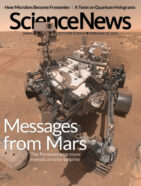This post was originally published on this site
Earth’s uneven layers
The rotation of Earth’s solid inner core may have recently paused relative to the mantle and crust and now appears to be reversing direction, Nikk Ogasa reported in “Earth’s inner core may ‘reverse’ its spin” (SN: 2/25/23, p. 7).
The inner core’s rotation is thought to be partly influenced by the mantle’s gravitational pull, Ogasa reported. Reader Robert G. Chester wondered how that could be true given the shell theorem, which states that a body inside a spherically symmetrical shell should experience a net-zero gravitational force.
The mantle indeed serves as a shell around the core. And if Earth’s layers were perfectly spherical and symmetrical, the inner core would not experience a gravitational force as it rotates, says geophysicist Yi Yang of Peking University in Beijing. But Earth’s structure is not uniform. The mantle is elliptical and its density varies, so the gravitational forces acting on the inner core at different points are not exactly the same, Yang says.
Plant power
Thanks to special motorlike cells, Mimosa pudica plants can close their feathery leaflets like a book when touched, Susan Milius reported in “How ‘plant muscles’ fold up a mimosa” (SN: 2/25/23, p. 13).
Reader Van Snyder mused over the variety of ways that plants move, from leaves that follow the sun to the killer close of Venus flytraps. Do these plant motions use different mechanisms?
Various mechanisms can drive plant motion, says biomechanist David Sleboda of the University of California, Irvine. “Sunflowers, for example, track the movement of the sun by only growing one side of their stem at a time, causing the stem to bend back and forth over the course of a day,” Sleboda says. In contrast, Venus flytraps use pressure building in specialized cells. The trap’s bowed shape increases speed and power for a “snap-buckle” close when prey enters the trap, he says.
While these mechanisms have distinct features, “almost all plant movements involve manipulation of water,” Sleboda says. Sunflowers draw water from the ground that inflates cells during growth. M. pudica and Venus flytraps shunt water within their bodies to make cells swell and induce motion. “Plants are hydraulic beings,” he says.
Milius’ story resurfaced fun memories for educator Maggie Eisenberger. “My middle school students, on a trip to Costa Rica, chose to investigate whether it was possible to fatigue the response to touch in [M. pudica],” Eisenberger wrote. “They timed the closing of the leaflets, then timed the reopening. Repeating the cycle with the same plant revealed that not only did the motion take longer each time, the leaflets also eventually failed to close very tightly or open fully,” she recalled. Her students “hypothesized that the motion was to deter leaf-eating insects, but if an insect persisted, it might still win the battle.”
Clarification
While describing quantum entanglement in “Store data with a quantum twist,” the story stated that something that affects one member of an entangled photon pair instantly affects the other (SN: 2/25/23, p. 12). It would have been more accurate to say that entangled particles have properties that are linked. Science News has previously explained in detail the nuances of talking about quantum entanglement. Read more about it here.

